Blog
This blog will contain fishing stories written by various anglers across Ostrobothnia, covering all disciplines of pike fishing in various environments.
Our latest blog is written by Timo Palokas, a keen recreational pike angler and promotore of best practise catch and release from Pietarsaari. In this blog he tells us about the need to start protecting large pike in Finland and follow in the footsteps of the british Pike Angler's Assocation of his impressions from the pike seminar, his us about his view on responsible pike fishing, his spin fishing experiences in different parts of Ostrobothnia, and new personal records.
WHY WE NEED TO START PROTECTING OUR PIKE
By Timo Palokas
In September we had our first pike seminar here in Pike Paradise, with speakers from the United Kingdom, Sweden, and of course, Finland. All the presentations were good and interesting, but my personal favourite was Steve Rowley’s presentation: ”What is required to make Finland a premier pike fishing destination?”. Steve not only discussed how to make Finland a premiere pike fishing destination for fishing tourists, but also for us anglers, who already are here.
Finland has a long history of false assumptions about pike, and still to this day ignorance is a reason why many large pike are getting killed. In the UK the pike anglers club has done a lot of work for pike welfare in the last decades. This is one thing we are currently missing in Finland. We do have many responsible pike anglers who know how important pike are in our waters, but still the information is hard to spread just by concerned individuals. We don’t really have any regulations on pike fishing, so anyone can fish for pike almost anywhere and kill all the pike they catch by almost any means, for example, netting and bow fishing.
The following points have been taken directly from pike anglers club’s website about sustainable pike fishing and it’s quoted here with permission from the PAC:
• Only fish for pike using strong and appropriate tackle – a minimum of 15lbs breaking strain monofilament line or 30lb braid is recommended.
• Always use a wire trace – 28lb minimum breaking strain with matching swivels – of an appropriate length – around eighteen inches when bait-fishing and at least eight inches for lures.
• Generally, an unhooking mat is recommended. These are widely available today, many being lightweight and easily rolled up to fit in a sling or holdall. If a mat is not available, then ensure that your catch is unhooked on thick, soft, grass. Experienced anglers, especially lure anglers travelling light, often unhook their catch in the water; for the inexperienced, however, consideration must be given to using a mat.
• Never go pike fishing without appropriate unhooking tools. These include long forceps (at least ten inches), wire cutters (for cutting hooks, if necessary) and long-nosed pliers. Unhooking gloves are also useful.
• Never use a pike gag – this Victorian invention is completely unnecessary (and now illegal in Scotland), cruel, and is damaging to pike – or American line grippers.
• Always use a large ‘specimen’ type landing net of at least 36 inches, with a soft mesh, and remember that the use of gaffs is now illegal.
• If weighing your catch, use an appropriately sized and shape weigh sling.
• If photographing your catch, never keep the pike out of the water from any longer than is absolutely necessary. This especially applies during the warmer months, when oxygen levels are low, water temperatures high – and pike fight so hard that they exhaust themselves. If a pike has fought particularly hard, and you need time to sort out handling equipment, consider retaining the fish in a pike tube or floating weigh sling; this gives the fish time to recover before weighing and photography. In the main, however, be organised, work quickly and only retain pike if absolutely necessary and for the minimum length of time –and only let the fish swim off when fully recovered.
• If in doubt, it is best to seek advice from an experienced pike angler.
Guidelines like this should be self-evident to all pike anglers. If we want to protect the biggest and the most valuable fish, we need some regulations in fishing and guide the anglers to handle their catches properly.
In Sweden the size of a pike you can kill is limited between 45 and 75 centimeters. This is a good idea to guarantee that there are enough small pike to have potential to grow big and once they grow over the 75 cm mark there is a better chance for them to grow bigger. In most of our waters there is a good population of small to medium sized pike, but the really big ones are rare in Finland. One reason for that is that many anglers kill the big pike when caught, for trophy or just because of ignorance as they think it will be to advantage to other fish populations, such as trout and salmon.
Pike fishing competitions in Finland have been like mass murders in the past, and still to this day in many pike fishing competitions you have to kill your catch. The catch is weighed at the end of the day, and then massive amounts of dead pike can just be thrown away as rubbish. Luckily the catch and release competitions are getting more and more attention and I really hope those pike culls would come to end soon. We have to educate anglers especially the younger ones on proper handling of pike and the importance of releasing, especially the biggest ones.
You can buy a lip-grip or a pike gag in almost any tackle shop, but proper unhooking mats and weighting slings are hard to find even in many bigger tackle shops. How can this be possible?
We don’t have a pike anglers club here in Finland as of today, but a lot of good information can be found on the PAC-website www.pikeanglersclub.co.uk. You can register as a member and pay the small annual fee to get the PikeLines magazine and of course support the good cause.
And then to some fishing...
I had the privilege to go pike fishing with the two British gentlemen who spoke at the seminar, Steve Rowley from EsoxWorld and Neville Fickling from Pike and Predator magazine. We had a nice day, fishing in great weather in the Kvarken Archipelago.
We didn’t catch any big pike, and since we ”only” caught about one hundred pike, we did not have such a good day in numbers by local terms.
|
|
|
Neville landing the first fish of the day in Antti Kiuru’s boat.
|
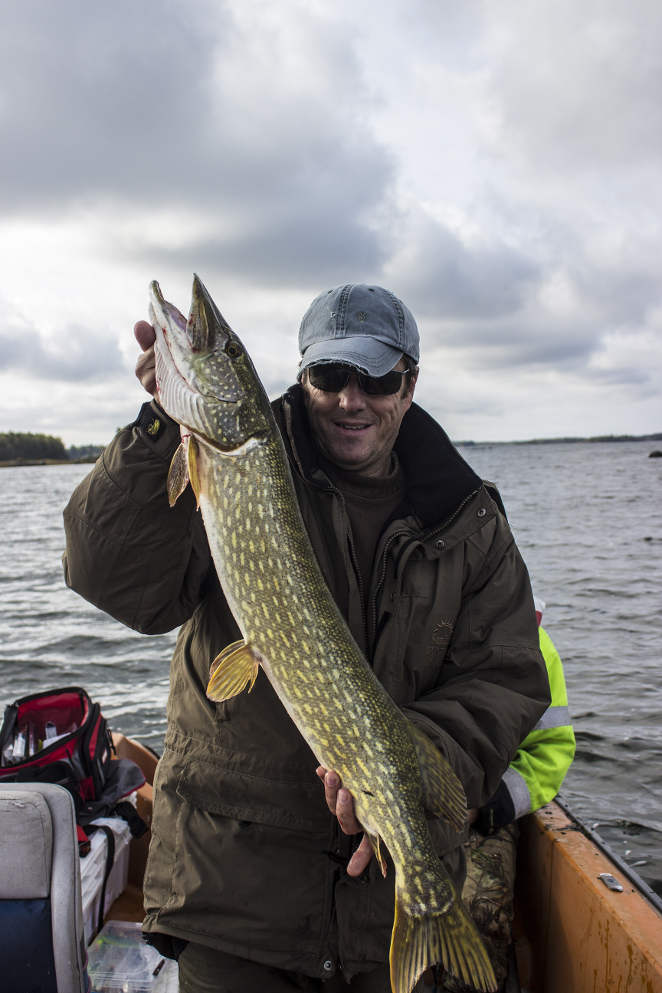 |
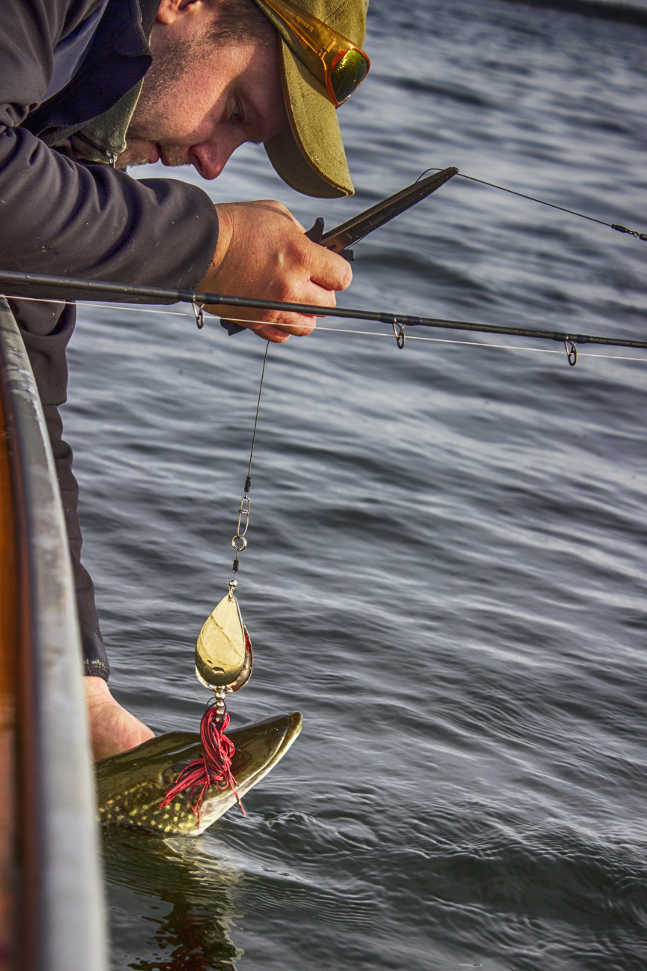 |
|
Steve’s trusty old spoon has a couple more teethmarks now :)
|
I tested my own 2-bladed spinner with flexible shaft, and it worked right from the first cast.
|
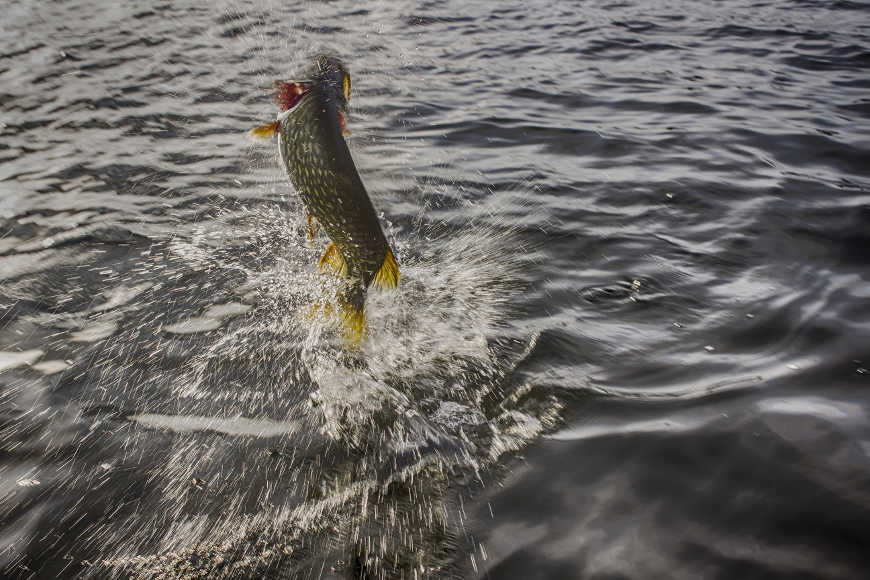 |
I enjoyed fishing with these gentlemen and the following week it was great to hear them present at the seminar. I have stayed in touch with both, and hopefully we get to fish together some time in the future. I’m grateful to the Pike Paradise Project for the opportunity of meeting these legends in person.
Timo Palokas
Uploaded 21.11.14
--------------------------------------------------------------------------------------------------------------------------------------------------------------------------------------
The following blog is written by Markus Sällinen, a great promoter of responsible recreational fishing and best practise catch & release. Read about his views on the changes to fishing regulations under way in Finland and about the Finnish Animal protection Organisation lobbying to ban C&R in Finland.
WHAT IS THE FUTURE OF SPORTFISHING IN FINLAND?
By Markus Sällinen
In the past month there has been a lot of discussion about fishing in Finland. Our Fishing Act is under reform and the new regulations should come to effect in 2016. Rod fishing without a reel will remain free of charge also in the new act. Ice fishing with a small reel or line storage will also be free. For waggler fishing, on the other hand, you need a permit according to the latest draft.
The best part of the renewal is the suggestion of having one permit that is valid for the whole country, which would cost 39 € per year. I have to admit that it is not much for a place like Finland. We have a lot of fish and plenty of places with really interesting and big fish. Crucian carp is one of them, and of course, the northern pike. These two species are often connected and if you find big crucian carp there is most certainly big pike in there too. I think most of the Finns that live near several fishing regions see this renewal as very welcome. No more worries if you live on the region border and have to buy up to three fishing permits to fish in your neighbourhood. These were the good news.
Animal activists want to ban C&R fishing
The bad news is that Finnish animal protection organisation (SEY) is lobbying to ban C&R fishing in Finland. They claim that C&R fishing causes unnecessary pain, stress and suffering and that a part of the fish will die after the release.
Impossible to choose what fish you will get - should I kill the fish I don’t want to eat among my catch?
In Finland there are several species that are protected with minimum length limits, for example, salmon, sea trout and zander. Unfortunately, there are no maximum-length limits to protect fish species. When you are out fishing it is impossible to choose what sized fish and what species you will get. Therefore, it is up to the fisherman to decide the fate of the caught fish. I would strongly suggest that all big fish should be released in favour of our waters and the future of, especially, predatory species. Today you have to release all fish that are under the minimum length, although the fish would be injured or dead. If I catch an injured fish shorter than regulated minimum length I would certainly kill it and then release it. So, there is no problem with the thought that the fish would have gone through a painful death. If a fish gets injured during fishing the best thing to do is to kill it. Of course, no one should release a badly wounded fish.

Best practice C&R means high survival
There is plenty of research showing that if the fish is handled well, survival is high. Here is a summary in of four studies done on the effect of C&R on pike by Tobias Fränstam and Jakob Lindström http://www.sportfiskarna.se/LinkClick.aspx?fileticket=jeXRGBn7KMo=&tabid=159 (in swedish)
Even scientists are in disagreements on whether fish can feel pain or not, so I’m not going to go into that. Regardless of whether fish feel or do not feel pain, every single fish should be regarded as a fragile individual that deserves the best possible handling in all situations. There are many things that can be done to protect fish from getting injured during C&R fishing. This is where Finns have a lot to learn.

Start using safe fishing methods.
- Use landing mats
- Safe links for leads
- Use barbless hooks
- Strip down the amount of hooks
- Bring forceps and wire cutters with you
- Don’t stand up when photographing your catch
- Use a weighing sack
- At least 50 cm traces for pike
- Don’t fish when it is too warm or cold
Now it is up to us who practice C&R fishing, and sport fishing related organizations like the Finnish Federation for Recreational Fishing, to enter the barricades and influence our way of fishing in the future. I suggest that SEY would start using their time to share knowledge about good handling of fish in all situations rather than their barbaric approach that every single fish that is caught should be killed.
What is the value of wellbeing of humans?
The value of C&R fishing for recreational fisheries goes far beyond the value of fish as food. Big fish that are released will make waters more attractive, and consequently, sell more fishing permits in the future. Fishing is one of the most popular pastimes in Finland and the value of wellbeing when you are out fishing can’t be measured in money. Fishing guides also make their living of fish, and especially, big fish. Most of the guides do set their own maximum sizes for fish. What would happen to their jobs if the customers could only catch 2 or 3 small fish on one trip?
Customers pay for a whole day; so on good days fish have to be released so you don’t end up with more fish than you tend to eat. Let us take care of our fish stocks and release those big individuals in the future too.
I will continue to fish for big pike, and I will certainly release every single one. Hopefully I will have a re-catch later in the future.
Tight Lines,
Markus
uploaded 5.11.2014
--------------------------------------------------------------------------------------------------------------------------------------------------------------------------------------
Who is to decide whether C&R fishing is morally right or wrong? (by Marina Nyqvist)
uploaded 6.11.2014
--------------------------------------------------------------------------------------------------------------------------------------------------------------------------------------
The following blogs are written by Timo Palokas, a keen recreational pike angler from Pietarsaari. In his blogs he tells us about his view on responsible pike fishing, his spin fishing experiences in different parts of Ostrobothnia, and new personal records.
SUMMERTIME PIKE FISHING
By Timo Palokas
It has been a while since my last blog, and much has happened in the meantime. Summer started nice and early because of the really warm winter/spring, but I’ll try to sum up the highlights of my summer in this post.
One week before the holiday I managed to catch my largest pike by length so far (118 cm), and so, my summer holidays were really off to a great start. In keeping with traditions, I went for a night fishing trip the evening my holiday started with my friend Danny. We started with some perch fishing to test my new jigging set, and caught a couple of small pike from strong current. I then had a good take on my 4” relax jig straight on the drop after the cast. I took my time and landed a pike, of exactly 1 metre in length, from the current using light perch gear and monofilament leader… nice start to the evening!
Pretty soon we changed location to really concentrate on pike fishing. Danny opened the game with a strong 104 cm pike on his second cast with a 30 cm savage gear real eel in golden ambulance colour. After that we fished for nearly 2 hours without a bite. I then changed to a jerk bait with my trusty savage gear freestyler in fungus roach colour. Maybe on my third cast, after a long cast I felt a bite. I stroke my rod up and felt the weight of a better fish, yes! I reeled the fish closer, it did couple of nice jumps out of the water and a nice long run. Danny lifted the fish below the gill plate to the unhooking mat, quick measurements and photo and back she goes. The pike had a really wide back and head, but looked a bit skinny like summer pike usually do, but still a 107cm and a great fish!
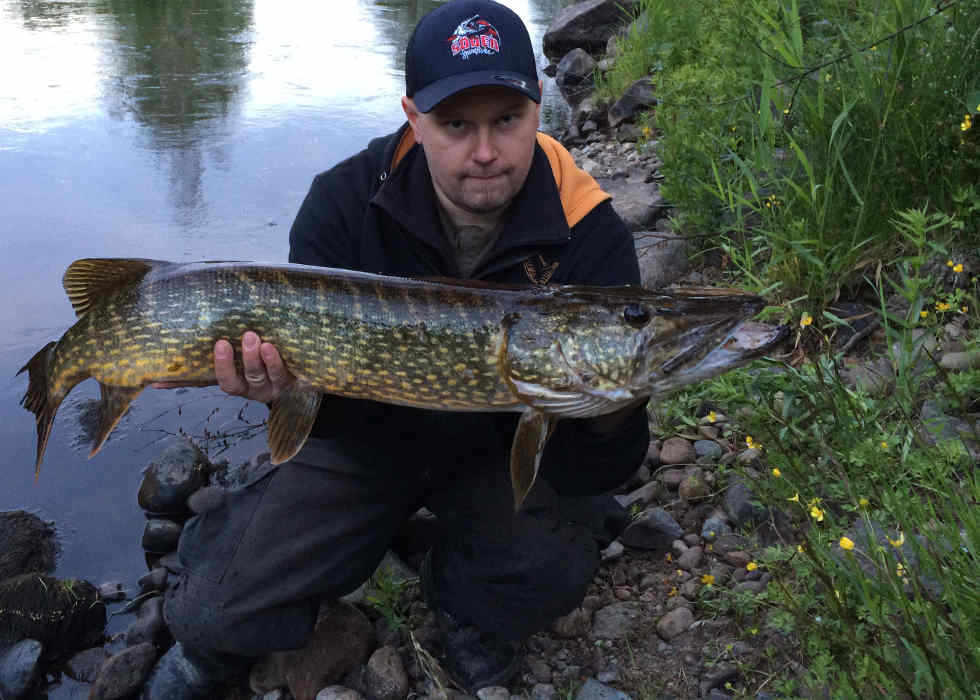 |
About a week later I arranged to meet a fellow pike angler and blog writer Jari Kettukangas. We were supposed to get Jari started with rubber lures since he’s a bit new to them. I sold my old rod to him and we did some rubber lures ABC before hitting the river. The first spot was a completely silent, no fish. I broke one of my rods in a cast though…(d’oh!). We moved to a second spot, and after a bit of casting Jari yelled 'FISH ON'! I ran to him with my camera and unhooking mat, and after a short struggle Jari lifted a nice summer pike onto the mat. A new casting pike record for Jari! The fish measured 110 cm and 47 cm in girth. After a short photo session Jari released her back to the river - what a start to a new fishing style!
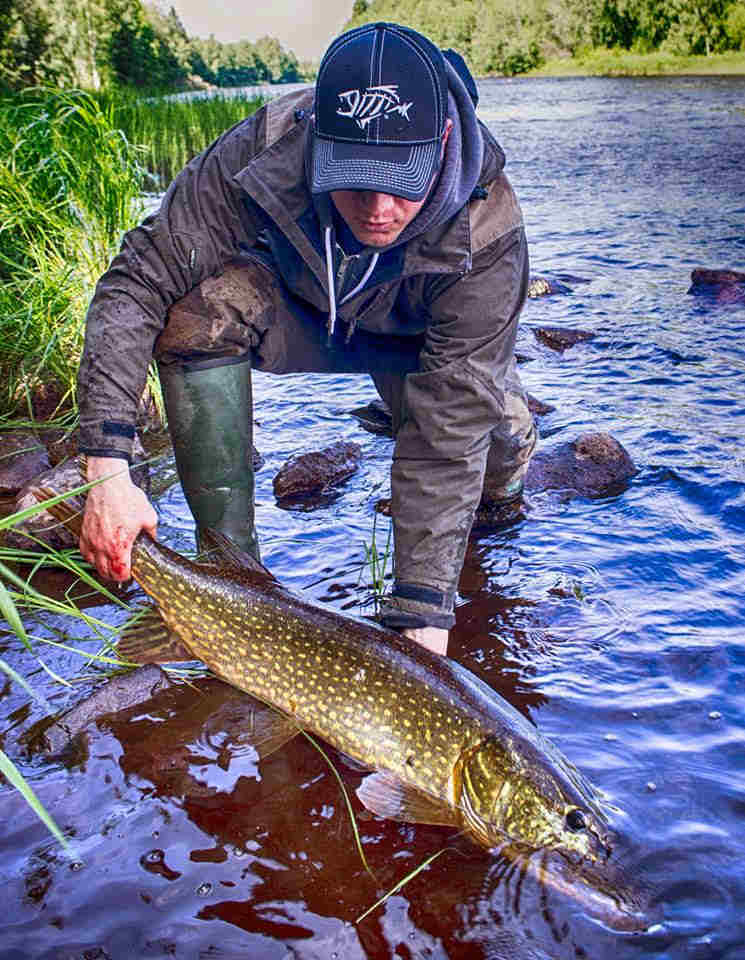 |
Finland had almost historically warm weather for over 30 days in a row this summer and the shallow water temperatures hit over 25°C. There is no point in fishing for big pike during such temperatures. They are hard to get to bite and if you do hook one, they recover really badly in poorly oxygenated warm water. So, I basically had to stop pike fishing for month and I just fished for perch in the meanwhile.
Now we’re getting closer to autumn, water temperatures have dropped to approximately 15°C, and the best part of the year for pike fishing is just around the corner. I went out last week to test if they are starting to bite, and results seem good ;) I caught a really nice 114 cm pike on a Svartzonkers big mcrubber shad rigged with my shallow screw and titanium stingers, and got a chance to test my new unhooking/weighting matt from gofish.fi. The X2 matt is about as good as it gets - I’m really happy with it! The pike had a wide back and a big head, and when this baby starts feeding for winter, she’ll probably tip the scales and make someone’s new record ;)
Now I’m just waiting for the weather to cool down even more, which will get the pike really going, and of course, there’s the pike seminar this month to look forward to as well ;)
Tight Lines!
Timo
uploaded 3.9.2014
HANDLE WITH CARE
by Timo Palokas
Nowadays many fishermen know the importance and benefits of releasing the large pike back to the water. The large pike are masters in keeping the fast growing roach and bream populations in balance. They also harvest sick or injured individuals, preventing them from producing offspring with possibly unfit genetic material, and at the same time, surviving and healthy individuals may pass on the genes that are more likely to produce more fish for us to catch. When you release a big pike that has been handled right, you also give someone else, or yourself, the chance to catch it again, maybe even at a bigger size next time…
I try to handle my catches with the respect they deserve and not cause any unnecessary harm to them. By using barbless hooks, an unhooking mat, and releasing them back to the water as quickly as possible, you can increase the survival rate greatly. Unfortunately, sometimes they are damaged and then the responsible thing to do becomes the opposite, i.e., not to release them. In the past three years I’ve had to kill only one big pike, and it was a nice 111 cm long river pike. The fish swallowed the small spoon lure so deep that my 50 cm leader was only showing a few centimeters outside the mouth.
This February I was fishing the local river with two of my friends. The weather was very nice, +8°C and sunny, and we caught a few small pike about 2-3 kg, but the bigger ones were not biting. We were about to quit for the day and were already heading back downstream stopping every now and then for few casts. I was casting my trusty 23 cm relax shad that gave me my personal record pike about week earlier. Then my friend had a strike, and I started reeling my lure back fast so I could take photos of his fish. Then I felt a take on my lure just under 10 meters from the bank. It felt like a good take, I was late setting the hook since I was not prepared at all, but fortunately, the fish was hooked well.
After a few runs the pike came nicely closer, my friend had waterproof trousers so he went to the edge of very slippery ice and grabbed the fish below the gill plate while I put the unhooking mat out. I removed the lure and took measurements of the fish, 107 cm and 10.5 kg, nice! We took a few quick photos and I released the pike back, and it just stormed away with a great splash as soon as I put her to the water, luckily we had that on video.
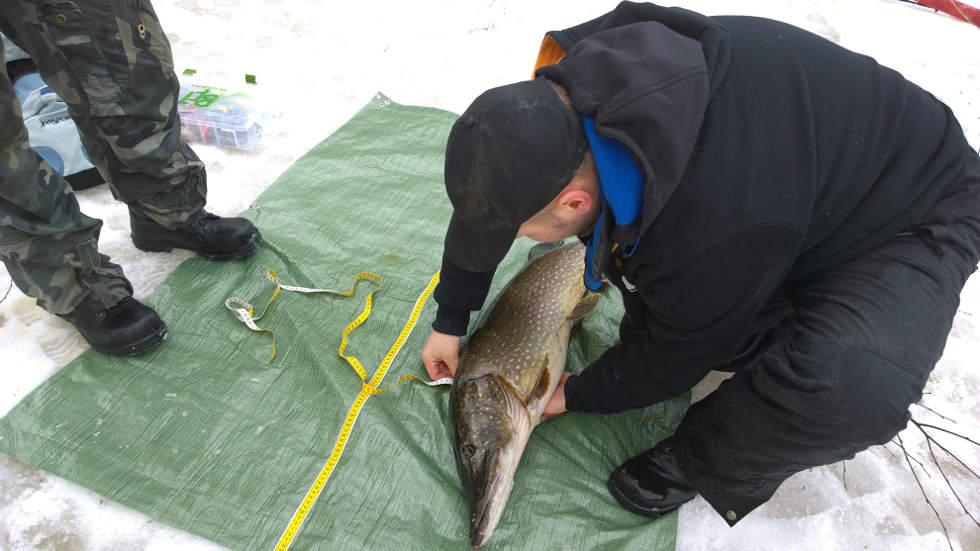 |
|
| Timo measuring the girth on the unhooking mat. | |
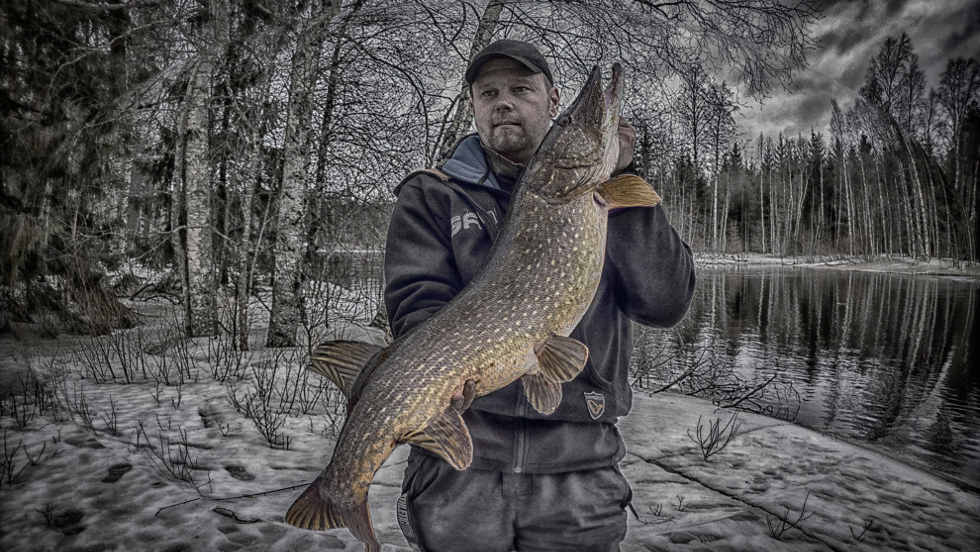 |
|
| Timo with a 10.5 kg pike. |
2-3 weeks later we were fishing the same river a couple of hundred meters downstream, when after a long day of fishing my friend Jonas finally had a good take. He said it felt big, so I stopped casting and started filming and getting ready to help if he needed. The fish surfaced near the shore after a short tug-o-war, and I took it up on lip lock hold. I took the photos and Jonas released the fish back, and we were done for the day and ready to hit the sauna. The fish was a nice just above 10 kg, Jonas’s new personal best and the first over the ten kg mark. That’s a good reason to celebrate!
|
|
| Jonas with his new personal record. |
Later on, an eagle eyed fellow fisherman noticed from the photos that the patterns on the gill plates matched in both of our fishes. I inspected the photos we had, and indeed it was the same fish we both caught. I’m already eager for the third encounter with this pike ;)
uploaded 7.7.2014
UNFORGETTABLE PRE-SPAWN PIKE FISHING
by Timo Palokas
This year, the incredibly warm winter weather opened new possibilities for pike fishing in Ostrobothnia, with open water available almost through the year; I had only a 2-week pause from casting in February when temperatures dropped below -20°C. Spinning/casting is very hard when temperatures drop below zero, because the line guides and braided lines start to freeze, but since there were lots of times in January and February when temperature kept over the freezing point, I had a great chance to open the pike season in January.
Since usually my pike season starts after the ice has melted much later in the spring, the question this year was where to find pike and what kind of lures would be the best option at this time. The pike were not yet in the spawning grounds, and neither were they in the faster currents or where they usually are found during higher water temperatures. A few trips were therefore needed to find the ”hotspots” in the river. I caught most of the bigger ones in deeper and calmer waters (in our rivers deep means about 2-4 m). Usually I like to fish for pike with jerk baits, but between January and March I had very little takes on jerk baits, and mostly smaller pike were attracted to them. The best results at least for me came with big rubber lures commonly known as shads. I used light jig heads (7.5 g with 10/0 hook) and weightless rigs called shallow screw, with 1 or 2 treble hooks as stingers. I was most successful with naturally coloured shads with lengths between 20 and 30 cm.
In mid-February I took a trip to the nearby river that I will probably never forget... The weather was + 5°C and raining. I was at the river at dawn, and the first few catches gave a couple of smaller pike between 1-3 kg, but after that it got quiet, and I casted nearly 2 hours without getting a take. I moved a couple of hundred meters up the river and found a nice open spot for casting, took a few casts with the 9” relax ripper shad that had given lots of fish this winter. No action, an hour went by without even a single bite, and I was getting frustrated. A short coffee break, and yet another long cast with the relax shad. I let the lure sink a little and started to reel slowly, making small stops every now and then, and after only couple of turns with the reel handle I felt a nip on my lure. I set the hook and immediately I felt the weight of the fish pulling the rod tip down. Yes! A better sized fish on!
I felt a few strong but slow kicks on the line but after that the fish came easily and surfaces near the shore. I saw that it was more than 1 m in length and estimated it to be between 8 and 10kg. Then I grabbed the fish below the gill plate in lip lock and lifted it gently from the water, and the moment the fish was out of the water I noticed how fat it was... it was enormous.
Then I noticed that I had forgot the unhooking mat at home in a hurry…damn… luckily I had taken my winter jacket off because of the warm weather. I placed the fish over my jacket and unhooked the lure, the unhooking mat is especially important in the winter to prevent the skin and mucus of the fish from getting damaged by the ice and snow. By the time I got the weighting bag ready I knew this is it, a new personal record! It was longer and fatter than anything I've got before.. Quick measure shows 117 cm in length and 65cm in girth, the fish looked like it could explode :) With shaking hands I set the weighting bag to the scale that showed 14 kg! After a few quick photos and a not very successful video shot of the fish in my arms, with a big smile on my face, I released the fish back to the water. It slowly swam back to the dark waters and I had time to take a few photos of the fish in the water.
|
|
.jpg) |
Many people around here have asked me why I released the trophy fish and why I didn’t eat it or have it stuffed on the wall... These big fish are much more important in the water passing on their genes to future pike and harvesting the roach and bream population in the waters, as well as keeping their own population under control. The feeling when that shovel sized tail slowly kicks off from your hand back to the water is something no trophy or good meal could compensate! It’s a feeling you cannot describe, you have to experience it!
Uploaded 27.5.2014







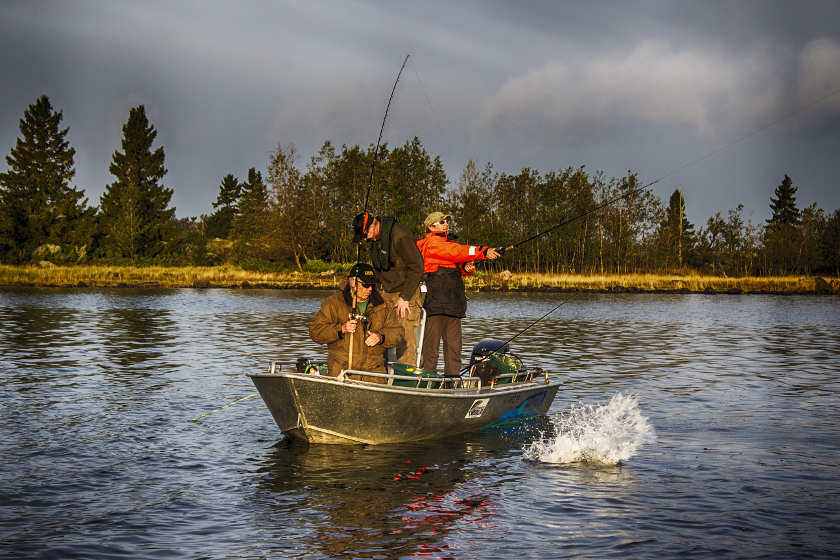
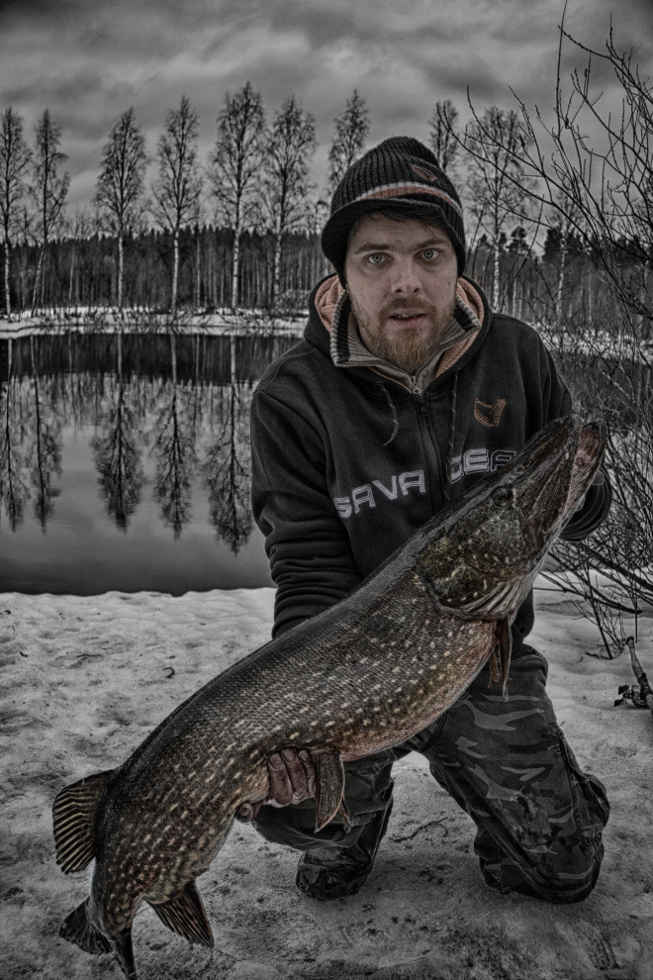
.jpg)


